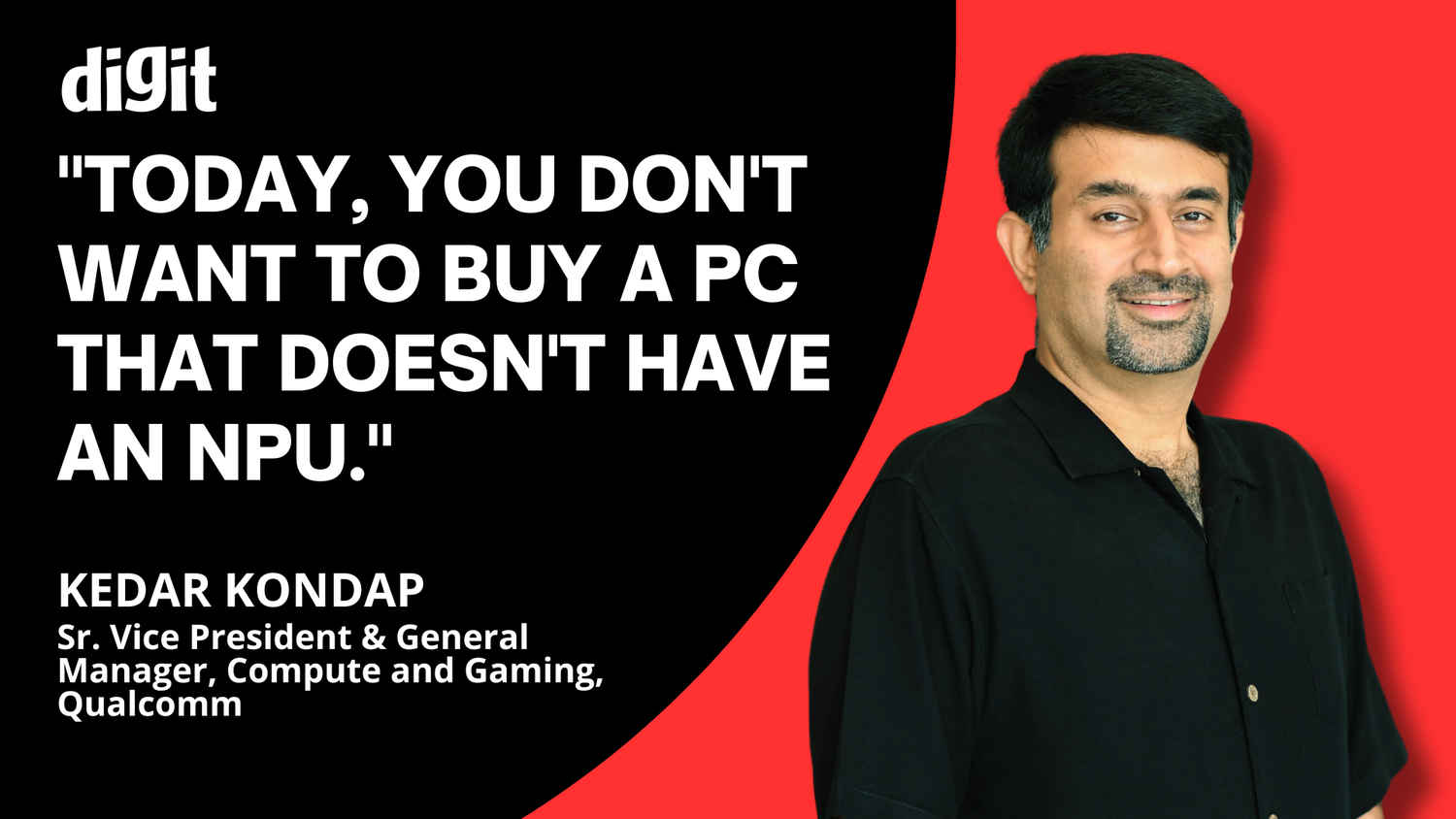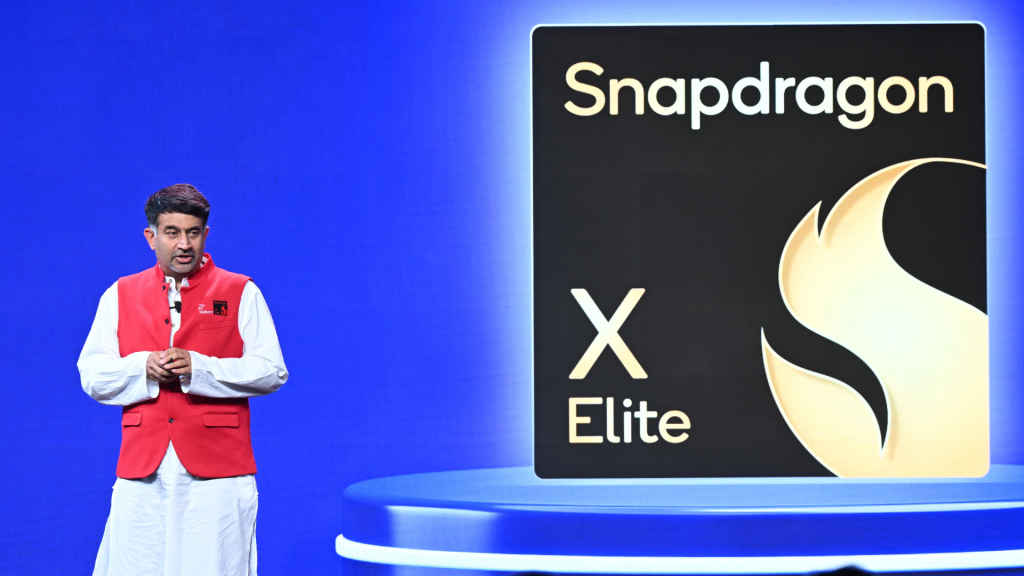In conversation with Qualcomm’s Kedar Kondap on the Snapdragon X Elite NPU performance, TOPS per watt, and the future of AI PCs

We caught up with Kedar Kondap, Sr. Vice President & General Manager, Compute and Gaming at Qualcomm, for a free-wheeling discussion that delved into the Snapdragon X Elite’s impressive performance, its efficiency prowess, and the future of gaming on the platform. In a candid conversation, Kedar opened up about the competitive landscape, the significance of performance numbers, and what’s next for the X Elite. He also shared his insights on the rapidly evolving AI landscape, the role of the NPU, and how Qualcomm is gearing up to meet the changing needs of consumers. From the gap in GPU performance to the potential for a beefier X Elite, Kedar addressed it all. Here’s what he had to say…
Digit: We’ve tested Qualcomm Snapdragon X Elite-powered laptops and compared them to Intel Meteorlake and AMD Zen 5-based laptops; the Snapdragon Elite surely takes the crown when it comes to battery life and efficiency, but when it comes to outright GPU performance, there is a significant gap. Is it that the games and GPU-intensive apps are not able to take advantage of the Adreno GPU, or is it the Prism emulation on Windows that’s holding it back?
Kedar: It depends on what you are testing with games and how we look at platform definition. We are very focused on optimizing apps and games. I don’t want to mislead the community that this is a gaming platform. At the same time, we have more than 1200 games optimized on the mobile side and we have elite gaming, we bring the legacy of partnerships with net engine and game developers. But at the same time, once you position this as a gaming PC, the expectations from gamers are very different. We are being careful that we don’t overposition the SD Elite PC as being a gaming PC, but we are optimizing gaming performance as well. You should look at the overall gaming experience that you get with the device.
We are focussed on TOPS per watt. We are looking more at that benchmark than just the TOPS number alone
Kedar Kondap, Sr. Vice President & General Manager, Compute and Gaming at Qualcomm
Digit: So is the Snapdragon X Elite promising more efficiency rather than outright performance? Will we see a beefier version of the X Elite that is targeted more at performance rather than efficiency?
Kedar: This is the beauty and the versatility of the silicon we provide. Unlike our competition which has multiple series like U, H, etc with varying TDPs. We offer the versatility of giving our customers the choice of what they want to do. We give them a piece of silicon and they can design the laptop with a TDP of their choice. You could design a 12-15W TDP device or you could choose to design the laptop with 55 or 80W TDP and harness the performance of the X Elite. Some devices have launched at 35-40, and you can go higher on the TDP. It’s not commercially launched yet but we did showcase some high TDP devices at the Snapdragon Summit last year. Overall our goal is to scale fast, as developers and apps are going at a rapid pace. We want to make sure that as many consumers can get access to it. There’s a big announcement planned at IFA 2024 in Berlin and you will know more about how we plan to scale and make Snapdragon X Elite powered PCs more accessible to a wider audience.

Digit: While internationally Snapdragon X Elite based laptops made it to the shelves some time back, in India we are now starting to see launches by all key brands. If you were to market X Elite laptops to laptop buyers, what is that big promise and advantage that SnapdragonX Elite powered laptops bring to the table?
Kedar: It is performance across three key vectors, Performance, Power, and AI. From the performance standpoint, you’ve already run the benchmarks and you’ve seen how snappy the performance is. Also, as you start using real-world applications you will experience the crisp and responsive performance of Snapdragon X Elite-powered laptops. When it comes to Power or battery life, you have tested it out for yourself, it is amazing. I use the device full-time and once you start using it, you will understand the difference as a Windows user. And the third is AI. We showed a bunch of applications and how the Apps can take advantage of our NPU. This is just the beginning. And it will bring the excitement back to Windows, we don’t think there’s been performance leadership in Windows and the Snapdragon X Elite will be bringing that leadership back again.
Digit: A lot of performance leadership today is centered around the NPU. It’s a sweeping statement, but is NPU the new CPU from a focus point of view?
Kedar: It evolved from the CPU decade to the GPU decade to I believe the NPU decade today. We invested a lot in the NPU development, we’ve had an NPU on the smartphone platform for several years. It’s just that the NPU is getting wider recognition now as models are evolving. So you have more than 100 models that we’ve optimized on the X Elite and once you start to showcase the benefits, you realize the advantages of the efficiency of the NPU. We deliberately picked intensive creator apps to showcase the benefits of NPU. It showcases the versatility of the NPU which leaves a lot of room for the CPU and GPU to run other tasks. You will see more and more applications getting ported to the NPU.
Digit: The whole story has been about on-device AI, privacy, and the reason why you need a powerful NPU. There’s also a mix of on-device and private cloud computing, we’ve seen Apple announce its Apple Intelligence which combines on-device AI and secure cloud-based computing to augment AI experiences. How do you see AI computing moving? For someone being in the industry for a long time and witnessing the changing trends, where are we heading?
Unlike our competition which has multiple series like U, H, etc with varying TDPs. We offer the versatility of giving our customers the choice of what they want to do.
Kedar Kondap, Sr. Vice President & General Manager, Compute and Gaming at Qualcomm
Kedar: It will surely be a combination. I think of it in three steps. You have on-device, we’ve shown how the X Elite with 13 billion parameter models. While your own AI Infranet or near-edge or private cloud, whatever we reference it as. You are going to have certain models that you can run in that environment. For example, instead of 13 billion, you can run up to 100 billion in a private cloud environment. But after that, you will go to the cloud. So, there’s always going to be three steps. And over time these numbers will change. On-device performance will scale higher, number will change. Accuracy will improve and you will have more NPU TOPs available on-device, for example, the 13 billion will become 30 billion or 50 billion, so on-device NPUs will become more powerful. So there will always be a hybrid model where certain use cases will run only on a device, certain in a closed infra environment, and certain will go only to the cloud.
Also Read: ASUS Vivobook S15 OLED Ft. Snapdragon X Elite Review: Better Than Intel Core Ultra 7?
Digit: You just mentioned TOPS, which seems to be the key and only metric when it comes to measuring NPU performance and now we have two numbers being marketed, NPU TOPS and total system TOPS, that take into account the CPU, GPU, and the NPU. And that number is a lot higher than the standalone number for the NPU. Is TOPS the only way to measure and quantify AI performance?
Kedar: It’s a very good question, and frankly, the answer is, that we don’t know yet to be honest. I don’t think there is a good metric yet that is defined. And it also doesn’t do justice to the performance per watt aspect when it comes to AI computing. Just because you have a higher number, doesn’t mean you have the most efficient NPU. You could be at worse power. So I don’t know if there is a metric yet and that is why we didn’t reference TOPS as much, but we focussed on TOPS per watt. We are looking more at that benchmark. There’s not an easy way to benchmark and compare them yet. And that’s why at Qualcomm we are more focused on driving experiences rather than just numbers. Even now I am very focused on driving experiences and not just pure specs. The reason why everybody is using TOPS is because there is no other benchmark or metric yet to measure performance. To be honest with you, I don’t know what the right metric is and we have started focussing on looking at TOPS per watt number. It’s very hard to tell you which is the right metric today. We are focused on making the consumer understand the kind of superior experience you get from a Snapdragon X Elite powered PC.
It has evolved from the CPU decade to the GPU decade to I believe what is the NPU decade today.
Kedar Kondap, Sr. Vice President & General Manager, Compute and Gaming at Qualcomm
Digit: Talking about the experience, what’s the reason for a consumer to pick an AI PC today? We’ve seen a delay in the Windows Recall feature which was touted to be this feature that will make everyone get a CoPilot+ PC. So, what’s the reason to upgrade?
Kedar: I think the question today is if you are buying a PC, as the apps are evolving fast, you want to buy a future-proof PC. Today you don’t want to buy a PC that doesn’t have an NPU. You are hearing all the apps and app developers like Adobe have talked about moving to the NPU. You want to buy a PC where it is ready for the shift to NPU from a software and application point of view. And the developments are super fast, we are talking days and weeks and not years. It’s all moving at such a rapid pace and ISVs are building and optimizing the applications to take advantage of the NPU. We trying to make it simpler for developers with all the tools, we’ve announced a developer kit, and we have the AI hub. So, we are enabling developers with access to hardware and software to accelerate the process.
Soham Raninga
Soham Raninga is the Chief Editor for Digit.in. A proponent of performance > features. Soham's tryst with tech started way back in Dec 1997, when he almost destroyed his computer, trying to make the Quake II demo run at >30FPS View Full Profile




